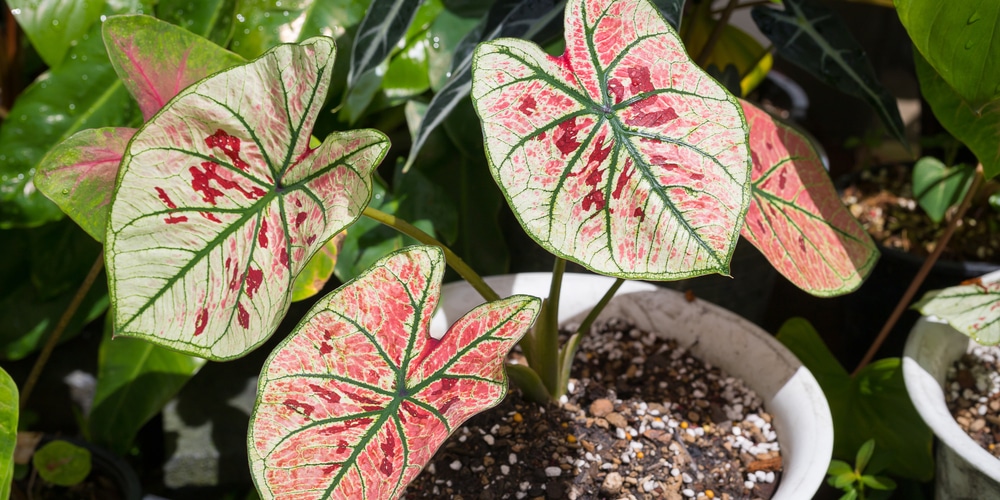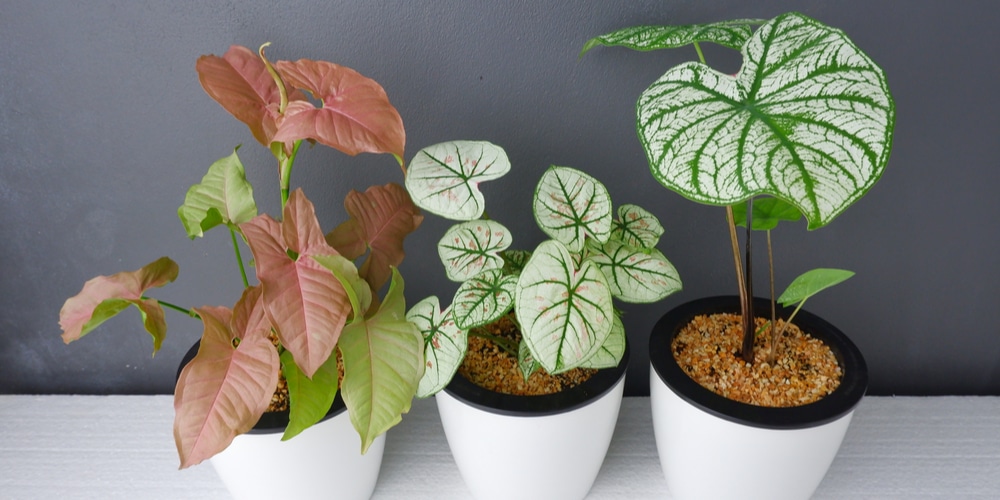The Araceae family gave birth to more than 2,300 species, and the Strawberry Cream Syngonium is one of them. For the record, it is one of the rarest varieties.
Not so much because you cannot find it in your flower markets—you can find it in many online shops anyways—but because finding one that achieves the right hue is pretty hard.
The way you take care of this plant will impact how it looks. So, here is what you have to know to give this beauty all it needs to thrive and stun you with its delicate cream pink color. Let’s get to it!
How To Care For The Strawberry Cream Syngonium

The Strawberry Cream Syngonium is the ideal solution to decorate every corner of your house with style. Being a Syngonium Podophyllum, this tropical hybrid plant is perfect for beginners. However, make sure its indoor habitat satisfies all the apparent requirements for successful adaptation before getting one.
Sunlight
The Strawberry Cream Syngonium is a versatile plant that can live in different light conditions. But if you put it in the wrong place, the leaves will not retain their cream pink color. So, it is better to keep this plant in the shade at all times.
Indirect lighting is the best method to provide the plant with enough sunlight to grow. If you put the plant outside or expose it to direct sunlight all day, the leaves will turn dark or grey. And it will never produce flowers. The more hours of indirect light, the better.
Providing absolute optimal conditions is the only way to induce this plant to flower indoors. Of course, light can disrupt the flowering process. So, if the plant were to flower, it is highly recommended not to change the lighting setting and hours of light.
Watering
All Syngoniums are not heavy drinkers. In that respect, the Strawberry Cream Syngonium is not that different. But it sure loves having constantly humid soil during the warmer seasons.
In spring and summer, you had better stick a finger into the soil at least twice a week. Or every three days. Check for moisture and give the plant a drink if the soil is dry.
When the plant needs water, the sagittate (arrow-shaped) leaves turn yellow, and the stems limp and floppy.
In winter, on the other hand, wait for the soil to dry on the surface before giving it water. Usually, watering the plant once a week is all it takes. But you will have to adapt during autumn as the temperature and humidity levels may fluctuate.
Pruning
You may get a little Strawberry Cream Syngonium in its nice pot. But soon, the compact and cute foliage will grow like crazy, losing its attractive arrangement. Even though this plant is a hybrid, it is still a vine. So, it will tend to crawl along, reaching for the ground to propagate.
Tip pruning is the best way to keep your plant nice and bushy. For the best results, only prune two or three times a year by cutting above a stem’s node, mainly during the warmer, growing season.
Keeping the foliage under control will prevent spider mites from moving onto the plant, especially if you keep it in a hanging basket.
Humidity
The Strawberry Cream Syngonium loves humidity. But if you can manage to keep a high humidity level (above 60%) without misting the leaves, the plant will thank you for that. Why? Because bacterial growth can be an issue for this genus of flowering plants.
Please, refrain from placing this plant near:
- dehumidifier
- fans (or under a ceiling fan)
- radiators
Turning on the humidifier in winter may help. But this plant is adaptive, so the chances of surviving the cold season without it are high.
If you find your plant to suffer from low humidity, try using a pebble tray.
USDA Climate Zones
The temperature around the plant should always be between 60 to 75 degrees. In detail, the ideal conditions include 68F and good air exchange. On a side note, the Strawberry Cream Syngonium hates cold air currents. So, protect it with frost covers if you have to. But no matter what you do, never let the temperature drop below 50F
If we look at the USDA Hardiness Zone Map, we will find that these plants belong to zones 10 through 12. Of course, you can grow them pretty much everywhere because they are popular indoor plants. But moving such a plant from one place to another may prove to be stressful for it in the colder months.
Fertilizer
Heavily diluting all-purpose fertilizer works like a charm in the warm seasons. You can follow the instructions on the label as long as you dilute it or use less than one-half of the recommended dosage. But using fertilizer in the colder seasons is not recommendable. It will increase the risk of root rot as the plant goes dormant in winter.
Soil Type
The ideal soil type for the Strawberry Cream Syngonium is balanced, light, and soft. In this way, the soil will absorb water easily. But it will not hold moisture for long, preventing the roots from rotting. A soft organic-laden substrate is best for optimal drainage.
Repotting the plants once a year may be necessary for optimal growth. But because repotting the plant may stress the roots, only proceed in the early spring. Or wait for the roots to emerge from the drainage holes. At that time, use a bigger pot and only add up to 1.5 inches of potting mix on either side to help the roots fill the whole space before the next repotting.
Propagation
Although it may be hard to find a node for a cut if you keep the Strawberry Cream Syngonium small and bushy, propagating it is pretty simple. All you need is a clean pair of scissors. Cut below the level of a node and put the stem into water. It will root in a matter of weeks.
Water propagation works well. But you should leave at least half an inch below the node you cut. And put the cutting in a place where it can get plenty of bright indirect light.
Related Article: Pink Syngonium Growth and Care Guide

